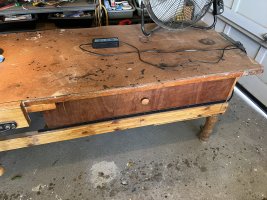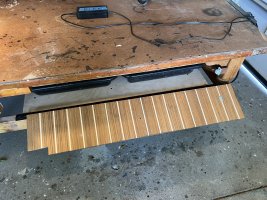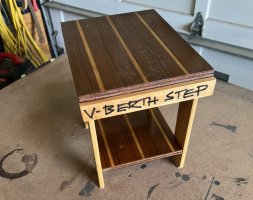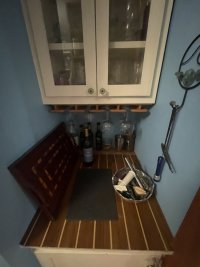-
Untitled Document Join us on March 28th, 7pm EDT
for the CBEC Virtual Meeting
EY.o March Zoom Meeting
All EYO members and followers are welcome to join the fun and get to know the people you've met online!
See the link below for login credentials and join us!
(dismiss this notice by hitting 'X', upper right)
You are using an out of date browser. It may not display this or other websites correctly.
You should upgrade or use an alternative browser.
You should upgrade or use an alternative browser.
Replacement of Cabin Sole [Master Thread]
- Thread starter Geoff Johnson
- Start date
JSM
Sustaining Member
If your coming to Chicago I can add to that pile !Me too. Maybe you and I should meet in Chicago so we can put the leftovers in one pile.
So far all I have made is a door for my workbench and a stool for the V berth. Outside the context of a sailboat it is weird stuff which fits in nowhere.
I like the idea of the v berth stool. We currently have a plastic milk crate filling that role.
Bolo
Contributing Partner
I came upon this video, “How to mark out and fit plywood into an irregular shaped space”, quite by accident on YouTube. After viewing it I thought that could (maybe) be helpful in laying out a new T&H deck if you don’t have the old pieces to work with that were destroyed in the removal process because the old glue worked too well which often happens. Yes, I know that you should make a template BEFORE removing the old sole (which I did) but what if for some reason you have a boat with the old sole gone or beyond using for a template. Anyway, it a clever way of laying something out and can be used for a variety of projects where the need fits.
The sound quality is terrible but you can get the whole idea behind this method even without the sound. Also, for using it on a boat the process would have to be modified because you can’t go nailing things down. You’ll see what I mean.
The sound quality is terrible but you can get the whole idea behind this method even without the sound. Also, for using it on a boat the process would have to be modified because you can’t go nailing things down. You’ll see what I mean.
He makes it complicated. I learned from watching the cabinetmakers of Tally Ho a simple and obvious method.
You collect some lengths of 1-2" wide thin material--typically door skin or Masonite--and hot-glue them together to fill the desired location. The resulting pattern is carried to the bench and traced, no need for measurements. You can build such a pattern to fit very complicated spaces. I wish I had known about this method years ago--it must be common knowledge among woodworkers.
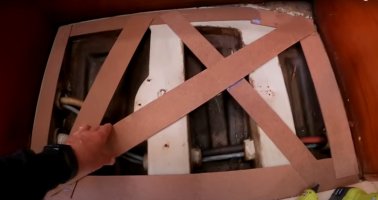
You collect some lengths of 1-2" wide thin material--typically door skin or Masonite--and hot-glue them together to fill the desired location. The resulting pattern is carried to the bench and traced, no need for measurements. You can build such a pattern to fit very complicated spaces. I wish I had known about this method years ago--it must be common knowledge among woodworkers.

Bolo
Contributing Partner
Yes, it did seem a bit involved, let’s say, but it does show a different way of doing the same thing (even though it’s not the best) but that holds true for a lot of things in life, doesn’t it? I do think that the way you show, Christian, is more suited to the conditions found on our boats. However if all you have on hand is a smaller piece (then the finish piece) of flat material then his way will still work but with more steps.He makes it complicated. I learned from watching the cabinetmakers of Tally Ho a simple and obvious method.
You collect some lengths of 1-2" wide thin material--typically door skin or Masonite--and hot-glue them together to fill the desired location. The resulting pattern is carried to the bench and traced, no need for measurements. You can build such a pattern to fit very complicated spaces. I wish I had known about this method years ago--it must be common knowledge among woodworkers.
View attachment 51801
This video looks like an alternative to the older woodworking method of making a "tick stick". I remember articles about this in Wooden Boat magazine decades ago. I suspect that its roots go back over a hundred years.
There are Utube videos about it and 'net articles. Here is one:https://smallboatsmonthly.com/article/a-quick-tick-stick/
With these marks and a flexible batten to define the curves, one can make a very accurate pattern for something like a bulkhead - or a sole.
There are Utube videos about it and 'net articles. Here is one:https://smallboatsmonthly.com/article/a-quick-tick-stick/
With these marks and a flexible batten to define the curves, one can make a very accurate pattern for something like a bulkhead - or a sole.

